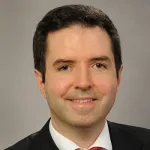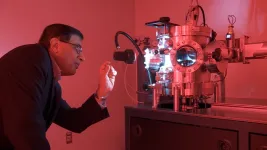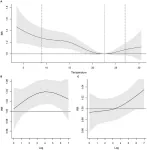(Press-News.org) Researchers in the Department of Biomedical Informatics (DBMI) at the University of Colorado School of Medicine have reached a major milestone in developing standards and tools for creating phenopackets that may foster more innovation and advancement in the medical field by allowing health professionals to more easily collect and share data.
A newly-released paper highlights the latest suite of coordinated standards and tools used to collect data related to rare diseases.
The phenopackets, a new Global Alliance for Genomics and Health (GA4GH) schema for sharing disease and phenotype information, characterize an individual patient or biosample. Those phenopackets, which can comprise a variety of data including genetic information, treatments, diagnoses and other information, can be especially useful for researchers because they are designed to be shared between people, clinics, and health systems.
“One of the challenges with clinical data is that it's usually collected for purposes such as billing, quality assurance, insurance or pharmacy orders. It's not designed to describe the patient as a biological subject,” explains Melissa Haendel, PhD, DBMI professor and chief research informatics officer for the CU Anschutz Medical Campus.
Haendel conceptualized the phenopacket standard as a way to broadly share characteristics of a patient and describe patients in a biologically meaningful way. Haendel is the co-founder of the Monarch Initiative, a GA4GH driver project that is dedicated to improving rare disease diagnostics, which have been hampered by the lack of patient-level data sharing. She also leads the National Human Genome Research Institute (NHGRI) Center of Excellence in Genome Sciences’s Phenomics First Resource, which provides funding for the phenopackets work.
“The phenopacket is an exchange standard to say, ‘How do we get patient phenotype information into and out of electronic health records? How do we send that information to clinical labs? How do we submit it to journals?’” Haendel says. “The goal is to take that set of features and be able to move them around in different contexts in a de-identified, non-personal way so that we can use those for understanding disease trajectories without any sort of compromise to patient rights.”
A world before phenopacket standards
Monica Munoz-Torres, PhD, associate professor in the DBMI and program director for Monarch Initiative and Phenomics First Resource, describes collecting phenotype data up until recently as “the wild West.”
“There have been tons of tools that have tried to capture clinical data,” says Munoz-Torres, also a co-developer of the standard. “The problem is that none of these previous models have actually been able to represent a general model for representing clinical data of individual patients with arbitrary diseases or the linkage to genomic and pedigree data for each of these patients.”
That realization almost a decade ago is what prompted the work on creating standards.
“We sat down and thought about how we fix that problem, so we partnered with GA4GH because we knew that this was a group that was rethinking how we make all the knowledge that we have about both genomics and health computable, transferable, and understandable.”
The starting place, Munoz-Torres says, was reaching out to potential stakeholders that could advise on their own genomics and health data needs and what they’d want to see in a phenopacket. Those conversations eventually led the researchers to creating their own easily implementable schema and the newly released tools.
“We figured the best way to do this in a programmatic manner was to design this schema and put it to the test. We received years of community feedback,” Munoz-Torres explains. “Now we've gone the extra mile to create a set of tools that make it easier to create, validate, and work with those phenopackets.”
The future for data sharing
An early indicator of how successful the work Haendel, Munoz-Torres, and their colleagues have conducted has been the adoption of the standard.
Almost 1 million phenopackets have been created to date from organizations all over the world, including the European Joint Programme on Rare Diseases and Japan’s biobank network. Releasing the phenopackets as a standard of the International Organization for Standards (ISO) ensures that even more governments and organizations around the world will be able to adopt them in the future.
The markers of continued success will be in the research community, which will be able to more easily collect and analyze data about rare diseases.
“We will be able to see people making discoveries that weren’t previously possible,” Munoz-Torres says. “They will be providing new knowledge.”
END
University of Colorado data scientists develop rare disease phenopacket standard, tools for global use
The ability to share de-identified information about patients across clinics, health systems, and countries will help researchers better understand rare diseases and make more discoveries.
2023-05-17
ELSE PRESS RELEASES FROM THIS DATE:
Press Release: ECOG-ACRIN announces the recipients of its 2023 scientific leadership and mentorship awards
2023-05-17
The ECOG-ACRIN Cancer Research Group (ECOG-ACRIN) announces the following cancer researchers as the recipients of the organization’s annual scientific leadership and mentorship awards. Through its Mentoring Program, ECOG-ACRIN formally recognizes outstanding scientific leadership through events and awards that identify, encourage, and recognize investigators in the early years of their careers. The program is expanding in 2023 with the addition of the Remarkable Mentor to Women in Oncology Award.
Young Investigator of the Year
Patrick M. Forde, MBBCh, is the 2023 recipient of the Young Investigator Award, a professional honor to recognize ...
UAB will lead an $8 million Department of Energy grant from the National Nuclear Security Administration, or NNSA
2023-05-17
BIRMINGHAM, Ala. – Yogesh Vohra, Ph.D., is the principal investigator of a five-year, $8 million grant from the United States Department of Energy’s National Nuclear Security Administration Stewardship Science Academic Alliances program that supports fundamental research in materials under extreme conditions and in advanced manufacturing.
Vohra, a professor university scholar in the University of Alabama at Birmingham Department of Physics and associate dean in the UAB College of Arts and Sciences, says the grant will leverage the expertise of nine faculty members across five disciplines at UAB and the University of Massachusetts-Amherst, ...
High-res Western drought forecasts could be on horizon
2023-05-17
Contacts:
David Hosansky, NCAR/UCAR Manager of Media Relations
hosansky@ucar.edu
720-470-2073
Ali Branscombe, NCAR/UCAR Communications Specialist
abran@ucar.edu
651-764-9643
A new computer modeling technique developed by scientists at the National Center for Atmospheric Research (NCAR) offers the potential to generate months-ahead summertime drought forecasts across the Western United States with the capability of differentiating between dry conditions at locations just a couple of miles apart.
The technique uses statistical methods and machine learning to analyze key drought indicators during the winter and spring and correlate them with the likelihood of dryness throughout the ...
CCNY researchers use structured light on a chip in another photonics breakthrough
2023-05-17
In everyday life we experience light in one of its simplest forms – optical rays or beams. However, light can exist in much more exotic forms. Thus, even beams can be shaped to take the form of spirals; so-called vortex beams, endowed with unusual properties. Such beams can make dust particles to spin, just like they indeed move along some intangible spirals.
Light modes with such added structure are called “structured,” and even more exotic forms of structured light can be attained in artificial optical materials – metamaterials, where ...
Higher blood sugar linked to faster loss of brain power in stroke survivors
2023-05-17
Surviving a stroke can bring many long-term effects – including a much higher risk of dementia. But a study suggests that blood sugar may play a key role in that risk.
Loss of general thinking ability happened much faster in stroke survivors who had high blood glucose in the years after their health crisis, even after accounting for other things that might affect their brainpower, according to a study published in JAMA Network Open.
Those whose blood pressures or cholesterol were high after their stroke did not lose points on tests of thinking ability, ...
Understanding how to best transform speech into tactile vibrations could benefit hearing-impaired people
2023-05-17
WASHINGTON – Researchers at Georgetown University Medical Center, in collaboration with George Washington University, leveraged their understanding of auditory speech processing in the brain to enable volunteers to perceive speech through the sense of touch. This may aid in the design of novel sensory substitution devices -- swapping sound for touch, for example -- for hearing-impaired people.
The findings appear in the Journal of Neuroscience on May 17, 2023.
“In the past few years, our understanding of how the brain processes information from different senses has expanded greatly as we are starting to understand how brain networks are connected across different ...
Henry Ford Health and Ephemeral Tattoo partner to study made-to-fade tattoo ink for medical markings
2023-05-17
DETROIT (May 17, 2023) – Researchers at Henry Ford Health — one of the nation’s leading integrated academic medical institutions — in collaboration with Ephemeral Tattoo, have conducted a study on the safety and efficacy of made-to-fade tattoos for medical markings.
Fifty to 60 percent of cancer patients receive radiation therapy during their course of treatment. Patients have traditionally been required to receive small, permanent tattoos on their skin to ensure therapy is delivered accurately to the same place each time while minimizing healthy tissue exposure to radiation. On the heels of this study, Ephemeral will offer its innovative made-to-fade ...
New UC Davis research using DNA changes origin of human species, researchers suggest
2023-05-17
In testing the genetic material of current populations in Africa and comparing against existing fossil evidence of early Homo sapiens populations there, researchers have uncovered a new model of human evolution — overturning previous beliefs that a single African population gave rise to all humans. The new research was published today, May 17, in the journal Nature.
Although it is widely understood that Homo sapiens originated in Africa, uncertainty surrounds how branches of human evolution diverged and how people migrated ...
A new understanding of human origins in Africa
2023-05-17
There is broad agreement that Homo sapiens originated in Africa. But there remain many uncertainties and competing theories about where, when, and how.
In a paper published today in Nature, an international research team led by McGill University and the University of California-Davis suggest that, based on contemporary genomic evidence from across the continent, there were humans living in different regions of Africa, migrating from one region to another and mixing with one another over a period of hundreds of thousands of years. This view runs counter to some of the dominant theories about human origins in ...
Low temperatures increase the risk of sickness absence, especially for women, young people and third sector professionals
2023-05-17
A retrospective study of temperatures in the province of Barcelona reveals that low temperatures increase the risk of going on a period of sick leave, due in particular to infectious and respiratory diseases. The study, carried out by researchers from Center for Research in Occupational Health (CISAL) and the Department of Medicine and Life Sciences at UPF (MELIS); the Barcelona Institute for Global Health (ISGlobal), an institution supported by the "la Caixa" Foundation and CIBER of Epidemiology and Public Health (CIBERESP), shows that the sectors of the population most affected are women, young people and ...
LAST 30 PRESS RELEASES:
Shingles vaccine linked to slower biological aging in older adults
A self-assembling shortcut to better organic solar cells
A two-week leap in breeding: Antarctic penguins’ striking climate adaptation
Climate risks to insurance and reinsurance of global supply chains
58% of patients affected by 2022 mpox outbreak report lasting physical symptoms
Golden Gate method enables rapid, fully-synthetic engineering of therapeutically relevant bacteriophages
Polar weather on Jupiter and Saturn hints at the planets’ interior details
Socio-environmental movements: key global guardians of biodiversity amid rising violence
Global warming and CO2 emissions 56 million years ago resulted in massive forest fires and soil erosion
Hidden order in quantum chaos: the pseudogap
Exploring why adapting to the environment is more difficult as people age
Society for Laboratory Automation and Screening welcomes new scientific director: Madeline M. Farley, Ph.D.
Austrian cow shows first case of flexible, multi-purpose tool use in cattle
Human nasal passages defend against the common cold and help determine how sick we get
Research alert: Spreading drug costs over the year may ease financial burden for Medicare cancer patients
Hospital partnership improves follow up scans, decreases long term risk after aortic repair
Layered hydrogen silicane for safe, lightweight, and energy-efficient hydrogen carrier
Observing positronium beam as a quantum matter wave for the first time
IEEE study investigates the effects of pointing error on quantum key distribution systems
Analyzing submerged fault structures to predict future earthquakes in Türkiye
Quantum ‘alchemy’ made feasible with excitons
‘Revoice’ device gives stroke patients their voice back
USF-led study: AI helps reveal global surge in floating algae
New method predicts asthma attacks up to five years in advance
Researchers publish first ever structural engineering manual for bamboo
National poll: Less than half of parents say swearing is never OK for kids
Decades of suffering: Long-term mental health outcomes of Kurdish chemical gas attacks
Interactional dynamics of self-assessment and advice in peer reflection on microteaching
When aging affects the young: Revealing the weight of caregiving on teenagers
Can Canada’s health systems handle increased demand during FIFA World Cup?
[Press-News.org] University of Colorado data scientists develop rare disease phenopacket standard, tools for global useThe ability to share de-identified information about patients across clinics, health systems, and countries will help researchers better understand rare diseases and make more discoveries.




